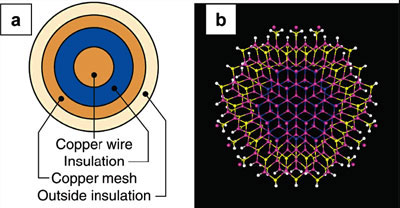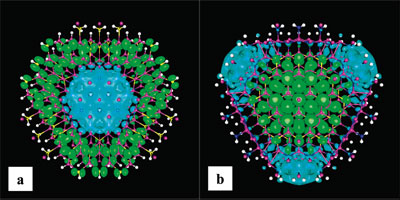| Posted: Apr 20, 2007 | |
'Quantum coaxial cables' for solar energy harvesting |
|
| (Nanowerk Spotlight) Nanowires have received a great deal of interest in recent years. As quasi one-dimensional systems they may overcome the fundamental difficulty in the electronic transport encountered when attempting to use quasi zero-dimensional structures (quantum dots) while still being able to take advantage of the effects related to quantum confinement. | |
| In a conventional semiconductor, electrons and holes typically stay in the same region after photoexcitation, which is very desirable for certain applications, light-emitting devices for instance. However, for a number of key renewable energy applications, including hydrogen generation via photoelectrochemical water splitting, dye-sensitized solar cells, and even regular solar cells, the efficient charge separation of the electron and hole after photoexcitation is instead highly preferred, although not readily available in the existing repertory of materials. | |
| In this context, researchers have explored the use of core-shell nanowires for such applications. However, for the material combinations that have been investigated, the energy alignments between the core and the shell are typically type I, and thus, the role of the shell is to either provide quantum confinement to both electrons and holes in the core or a protective cladding to the core to reduce sensitivity to the environment. | |
| Researchers at the National Renewable Energy Laboratory and Lawrence Berkeley National Laboratory designed a new class of core-shell semiconductor nanowires with strong type II band alignments. The photo-generated electron and hole in such nanowires are naturally separated in the core and shell, respectively, making them much more suitable for the solar energy applications than type I core-shell nanowires. | |
| "Conceptually, this work is an extension of our extensive research experience in the area of isoelectronic impurities in semiconductors, nitrogen in GaP for instance, which was the key material for green LEDs in the 1970-80's" Dr. Yong Zhang explains to Nanowerk. "In recent years, GaPN alloys with a small amount of N have received considerable interest in solar energy applications. However, on one hand doping nitrogen in GaP randomly cannot offer the most desirable electronic structure, and on the other hand, the alloying approach poses a fundamental limitation, that is, the reduction in the electronic transport. Our experience with impurity and alloy related research and the understanding of the specific needs for each solar energy application have motivated us to design GaN-GaP core-shell wires that can circumvent those limitations, at least in principle, and have the flexibility to address the specific material problems faced by different applications." | |
 |
|
| (a) Schematic of the cross section of a conventional coaxial cable. (b) Cross-section view of a “quantum coaxial cable”, a GaN-GaP core-shell nanowire, with a GaN core, GaP shell, and hydrogen passivation shell (N, blue; P, yellow; Ga, magenta; H, white). The size of the wire is 4 nm. The horizontal axis is in the zinc-blende [-1h10] direction, and the vertical is [-1h1h2]. (Reprinted with permission from American Chemical Society) | |
| Zhang is a senior scientist at the National Renewable Energy Laboratory (NREL), the primary laboratory for renewable energy and energy efficiency research and development in the U.S. Together with his colleagues he published a paper on these semiconducting nanowires in a recent issue of Nano Letters ("'Quantum Coaxial Cables' for Solar Energy Harvesting"). | |
| Zhang points out that, although the examples illustrated in the paper are core-shell nanowires based on III-V materials, the design can be extended to II-VI materials with similar band alignments (e.g., the pair of ZnO and ZnSe). | |
| A conventional coaxial cable is a two-conductor cable consisting of a central wire conductor symmetrically surrounded by a braided conductor with an insulating spacer in between. The NREL researchers showed that it is possible to design a core-shell semiconductor nanowire, such that the electron and hole wavefunctions are naturally confined in the core and shell region, respectively, without even having to introduce a barrier layer (the spacer) in between. | |
| This special types of core-shell semiconductor nanowires – termed 'quantum coaxial cables' – can offer a highly desirable but not readily available electronic structure, namely the spontaneous charge separation of the electron and hole, for use in key solar energy applications. | |
 |
|
| Cross-section views of charge distributions of the conduction band minimum (CBM) electron state (cyan) and valence band maximum (VBM) hole state (green) in core-shell nanowires: (a) GaN(core)-GaP(shell); (b) GaP(core)-GaN(shell). The color codes for the atoms are the same as in the image above. (Reprinted with permission from American Chemical Society) | |
| The current paper intends to address different specific problems associated with three important areas of using solar energy, and thus the potential applications are targeted toward these three areas: 1) Hydrogen generation via photoelectrochemical water splitting, for which the new materials may offer optimized band structure and much better material stability. 2) Dye-sensitized solar cells, where the new materials may provide replacements for the generally less stable sensitizers – dye molecules – with solid state sensitizers and also greatly extend the coverage of the solar spectrum. 3) Conventional solar cells, for which the new materials can minimize the radiative recombination loss and cover nearly the whole usable solar spectrum in one single ternary system (e.g., from < 0.5 eV to > 3.0 eV with GaN-GaP). | |
| Besides these practical and important renewable energy applications, being an unusual type of quasi one-dimensional system, quantum coaxial wires are expected to open up new avenues for studying novel physics and material sciences in reduced dimensionality, including electronic conductivity, electron-hole correlation, spintronics, and ferroelectricity. Beyond the renewable energy applications, they could have numerous other exciting applications ranging from quantum computing to nanoelectronics. | |
| The next step for Zhang and his colleagues is to demonstrate a proof of principle device in one of the three solar energy areas mentioned above, and then to optimize the design and device performance. One of the major issues is how well the core-shell structures could be grown because the materials involved, GaP and GaN for instance, have fairly large lattice mismatch. | |
| "We are also very interested in basic physics research with such unique quasi 1-D systems in areas such as electronic and thermal transport, electron-hole correlation, spintronics, and ferroelectricity" says Zhang. | |
 By
Michael
Berger
– Michael is author of three books by the Royal Society of Chemistry:
Nano-Society: Pushing the Boundaries of Technology,
Nanotechnology: The Future is Tiny, and
Nanoengineering: The Skills and Tools Making Technology Invisible
Copyright ©
Nanowerk LLC
By
Michael
Berger
– Michael is author of three books by the Royal Society of Chemistry:
Nano-Society: Pushing the Boundaries of Technology,
Nanotechnology: The Future is Tiny, and
Nanoengineering: The Skills and Tools Making Technology Invisible
Copyright ©
Nanowerk LLC
|
Become a Spotlight guest author! Join our large and growing group of guest contributors. Have you just published a scientific paper or have other exciting developments to share with the nanotechnology community? Here is how to publish on nanowerk.com.
